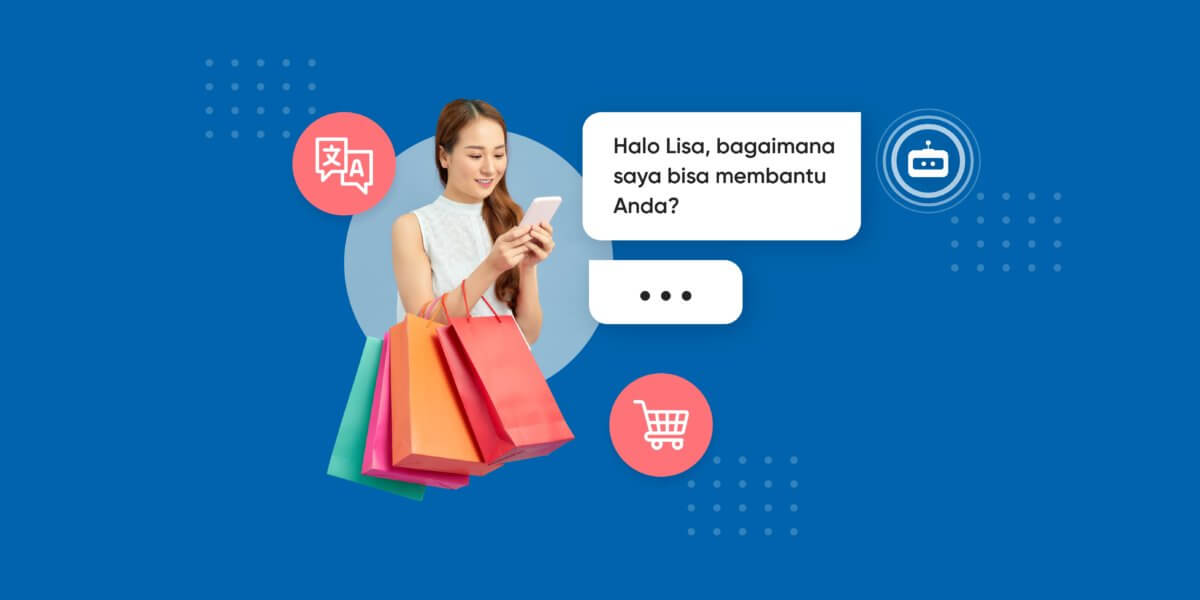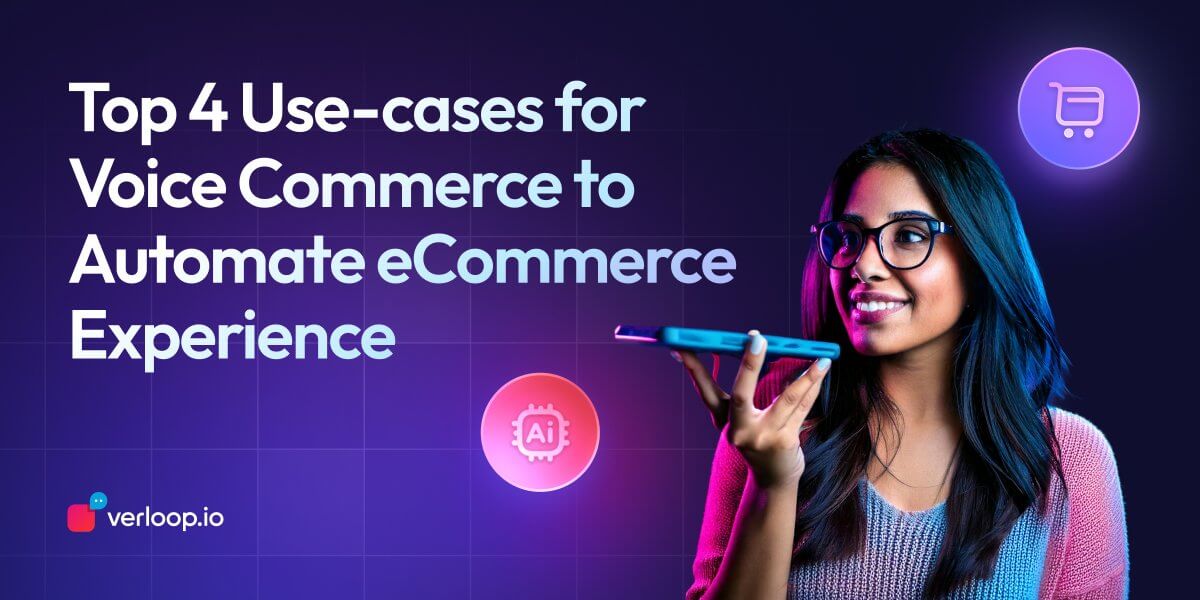Create a Chatbot: Why Your Ecommerce Platform Needs a Chatbot Today

Create a Chatbot: Why Your Ecommerce Platform Needs a Chatbot Today
If you’re running an e-commerce store, you don’t need me to tell you that it’s a difficult endeavor. For every report that says e-commerce is trending upwards, there are a hundred new entrants to the market. By adding an eCommerce chatbot can gain you traction in this digitally congested world.
And it isn’t just small fish in a big pond anymore. You have companies the size of small economies powered by the latest in weapons-grade technology matching up against out-of-my-backyard stores run by grandmothers who use email to talk to their customers.
The temptation to succumb to just getting more people through your digital doors is ever-present, but research suggests there are more effective ways to sell more.
Service Better, Sell More.
With the appropriate allocation of resources like eCommerce chatbot, you can ensure you match up to the big dogs. Take for example the following, relatively well-known statistic.
#1 - Winning a new customer costs 6 times more than retaining an existing one.
This is perfectly understandable for the most part. Marketing is all about conversion and most traditional tools are ludicrously bad. If you use emails to run campaigns, like so many of us do, you’re basically flushing money down the drain.
Only one out of five emails are ever opened, and even fewer viewed. The average of unopened emails at 80%. That’s over 60 trillion unopened emails, lying around in inbox cemeteries across the world. Think about what kind of wasted monetary opportunity cost 60 trillion dead emails represent. The average click rate of emails (how many successfully delivered emails get at least 1 click) is 2.43%. That’s 97.57% of emails you send that never see any engagement
Suffice to say that if you invest in great customer support (rather than solely in sales generation), you’re getting a lot more bang for your buck. If you find a solution that helps with both, you’re gold.
Onto a less prominent, but equally revealing statistic.
#2 - The probability of selling to an existing customer is up to 14 times higher than the probability of selling to a new customer.
Another stone in the bucket for great customer service.
A loyal customer base, driven through excellent and immediate service and support puts you in a better position to beat the big, bad bullies of the e-commerce world. But delivering quality customer support is a long-term undertaking that is difficult to do, which is why most companies just settle for pushing more through their sales funnel.
Think of it this way: It feels a lot more rewarding to spend $50 right now and see a 10% increase in your website traffic overnight, than it does to spend $100 dollars on customer support to ensure your customers are happier in the long term. But happier customers buy more, so while you could get $60 worth of business for that initial investment of $50 and consider it a success, you could’ve made $600 by selling to your existing customers.
Existing customers, who aren’t subjected to high-effort purchase experiences have been shown to –
- Buy more (higher cart values)
- Buy more often (more frequently)
- Close more (60%-70% chance vs 5%-20% for a prospect)
- Close faster (in lesser time)
- Spend more (33% per purchase more) and
- Save more (for you)
#3 - Research by Frederick Reichheld of Bain & Company (the inventor of the net promoter score) shows that an increase in customer retention rates by 5% increases profits by anywhere between 25% to 95%.
So far, we’ve covered that better customer support and sales for existing customers equates to cheaper and easier transactions for you. But what effect does that have on your bottom line?
Well, global consulting firm Bain along with Harvard Business School set out to study just that, and the results they came to were astonishing.
“We showed that in industry after industry, the high cost of acquiring customers renders many customer relationships unprofitable during their early years. Only in later years, when the cost of serving loyal customers falls and the volume of their purchases rises, do relationships generate big returns. The bottom line: a 10 percent rise in customer retention yields a 30 percent increase in the value of the company.”
Customer Retention is like Conversion Rate, even a 2%-3% increase in either can increase your profits by up to 100%. A company’s ability to sell and service to their existing customers is directly tied to their bottom line; the better you do at one, the more you’ll have of the other. But as we’ve discussed earlier, excellent customer support is a difficult feat to accomplish.
Suggested Reading: 5 Effective Ways to Increase your Conversion Rates
So what exactly are the barriers companies face in delivering that exceptional customer support and sales?
a. Time
From both a support and sales standpoint, the amount of time you
a. take to reach out to them and
b. take to resolve their query
be it post-purchase or purchase decision, is of the utmost importance. Research has shown that there is a 10x decrease in the odds of making contact with a lead after the first 5 minutes. Responding in 10 minutes vs. 5 minutes equals a 400% decrease in your odds of qualifying a lead. Sure you could have lots of representatives who made sure that all your customers were engaged as quickly as possible, but.
b. Scale
If you have hundreds of prospects and customers flooding your system at the same time, they’re not going to be serviced in the same way. A lot of the pipe will either be forced to wait (read point 1) or will have a sub-standard experience. As companies grow, they need to be able to build all functions of their business at scale, including sales and support, but this can’t be solved simply by simply hiring more people. Sales and Support are asynchronous, which means that they’re fundamentally 1:1 conversations, and at a certain point, it becomes financially unsustainable to have one employee for one customer or prospect.
c. Quality
You could have a kick-ass sales and support strategy, filled with compilations of the latest research and the best tricks. You could’ve invested many hours and dollars into setting up an elaborate system that would help get the most out of your offerings. But if your team doesn’t follow through with it, then it’s all for naught. Sales and Support employees have difficult jobs. It’s mentally and emotionally taxing, they work long hours and often six or seven days a week. It isn’t surprising when and if they burn out, but often your customers and prospects are at the receiving end of that wrath.
Related: Best eCommerce Tools Curated Just For You
One Stone, All the Birds.
What you need is something that allows you to talk to new prospects and sell to existing customers. This shouldn’t be a monetary black hole, delivers quality but doesn’t subject anyone to a high-effort experience. It should also improve customer loyalty/interaction/conversion, and does all of this quickly, at scale and with consistent quality.
So how do you find this magic solution?
Well, a good place to start is by looking at what customers already like – eCommerce chatbot.
While Social Media has been all the rage, for better or for worse, there has been a more silent shift in user preferences over the past few years. As customers have moved on from desktops and time-delayed tools of communication to more mobile and responsive alternatives, they’ve begun to embrace messaging as their platform for communication.

Research from Harvard Business Review and Bain Consulting found that only 7% of businesses responded within the aforementioned recommended five minutes. The common thread? All of them used live chat and eCommerce chatbot on their websites.
And when phone calls and emails fail customers so spectacularly, it isn’t difficult to understand why customers want to use messaging to communicate with businesses in real-time. In a recent Twilio survey, 89% of consumers said they want the option to talk to businesses through conversational tools like messaging. And this inefficiency isn’t just limited to Sales.
Email still remains a popular tool for Customer Support, and that takes a toll on your business. There is no customer that would rather have his support ticket addressed later than sooner. To understand the scale of the problem, consider this statistic.
According to research, the average response time to handle a customer service request using emails is 12 hours and 10 minutes. Think about that statistic; in a world of instant gratification where your friends and family are never more than five seconds or a text away, a business taking twelve hours to get back to you is nothing short of a crime.
Related: Conversational Commerce: Redefining eCommerce
So, What is an eCommerce Chatbot?
Simply put, eCommerce chatbot is a tool that helps companies take advantages of the internets core offering; Being the most potent communication interface in the history of humanity. While companies settle for blasting spam emails, chatbots allow you to interact with each individual customers or prospect that arrives at your website.
- Consistent – eCommerce chatbot is powered by Artificial Intelligence, they eliminate any possibility of human error, making for smoother lead creation and conversion. Chatbots are also self-learning, so they constantly adapt to grow even more efficient over time. This means you can ensure that every single customer has a fulfilling experience, regardless of where and what time they arrive at.
- Conversational – eCommerce chatbot replicate everyday human interaction more accurately than actual humans do. The vocabulary we use with our friends and family doesn’t cross over in companies interactions with clients. Single word commands on FAQ pages like “download”, “log-in”, “click here” is how businesses suffer from social communication disorder and lose customers.
- Compatible – eCommerce chatbot is endlessly malleable, regardless of business or function from simple lead generation to full-fledged automated sales, all made possible by a little pop up on the bottom right of your screen. Regardless of whether your primary product exists on a website, app or social media platform, you can use Chatbots on all of them to deliver a consistent quality experience.
- Cost Effective – eCommerce chatbot isn’t just less expensive compared to their alternatives, they’re an outright steal. You can build a bot in under 5 minutes for free, and professional plans start at just $49.






